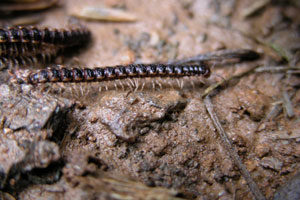Vol. 10 Issue 3, Fall 2005
By Nicole Hamilton
Millipedes are often seen around our houses in gardens, in heavily mulched flower beds and in compost piles. In the woods, they can be found under stones, under leaf litter and under logs. They generally lead a hidden life, but when conditions become too hot and dry, they will come out to find moisture.

Photo by Nicole Hamilton
Similarly, when it is too wet and soils become saturated, millipedes will come to the surface to find higher ground. We will often see them during these times on siding and along concrete foundations. Another time that we see them is in the fall as they migrate to their over-wintering sites.
Sometimes these sites include our basements or crawl spaces, but they often die here after a few days since they cannot find the proper moisture. The best thing to do is send your millipede guest back outside to find a better winter spot under the leaf litter. Millipedes overwinter as adults and lay their eggs in moist soil in the springtime.
While they do indeed have a lot of legs, millipedes do not really have a thousand as their name implies. In fact, they have up to 260 legs, which is still a lot of legs to coordinate and get moving. In order to grow, millipedes molt, and each time they do, another pair of legs is added. Each leg pair has its own body segment. Millipedes grow to about 1” long.
The legs do not necessarily move simultaneously, so it is difficult for the insects to move quickly. Instead, if threatened, the millipede may roll up into a ball and/or release a stinky spray from its sides to deter enemies. This spray is not poisonous, however, just unpleasant to smell. Millipedes do not bite. They eat decaying materials such as leaves and dead wood, and they prefer damp, cool, dark places. Individuals can live for several years.

